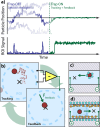Label-Free Anti-Brownian Trapping of Single Nanoparticles in Solution
- PMID: 39634022
- PMCID: PMC11613540
- DOI: 10.1021/acs.jpcc.4c05878
Label-Free Anti-Brownian Trapping of Single Nanoparticles in Solution
Abstract
Today, biomolecular nanoparticles are prevalent as diagnostic tools and molecular delivery carriers, and it is particularly useful to examine individuals within a sample population to quantify the variations between objects and directly observe the molecular dynamics involving these objects. Using interferometric scattering as a highly sensitive label-free detection scheme, we recently developed the interferometric scattering anti-Brownian electrokinetic (ISABEL) trap to hold a single nanoparticle in solution for extended optical observation. In this perspective, we describe how we implemented this trap, how it extends the capabilities of previous ABEL traps, and how we have begun to study individual carboxysomes, a fascinating biological carbon fixation nanocompartment. By monitoring single nanocompartments for seconds to minutes in the ISABEL trap using simultaneous interferometric scattering and fluorescence spectroscopy, we have demonstrated single-compartment mass measurements, cargo-loading trends, and redox sensing inside individual particles. These experiments benefit from rich multiplexed correlative measurements utilizing both scattering and fluorescence with many exciting future capabilities within reach.
© 2024 The Authors. Published by American Chemical Society.
Conflict of interest statement
The authors declare no competing financial interest.
Figures







Similar articles
-
Interferometric Scattering Enables Fluorescence-Free Electrokinetic Trapping of Single Nanoparticles in Free Solution.Nano Lett. 2019 Jun 12;19(6):4112-4117. doi: 10.1021/acs.nanolett.9b01514. Epub 2019 May 24. Nano Lett. 2019. PMID: 31117762 Free PMC article.
-
Exploring Masses and Internal Mass Distributions of Single Carboxysomes in Free Solution Using Fluorescence and Interferometric Scattering in an Anti-Brownian Trap.J Phys Chem B. 2022 Nov 3;126(43):8747-8759. doi: 10.1021/acs.jpcb.2c05939. Epub 2022 Oct 25. J Phys Chem B. 2022. PMID: 36282790 Free PMC article.
-
Ratiometric Sensing of Redox Environments Inside Individual Carboxysomes Trapped in Solution.J Phys Chem Lett. 2022 May 26;13(20):4455-4462. doi: 10.1021/acs.jpclett.2c00782. Epub 2022 May 13. J Phys Chem Lett. 2022. PMID: 35549289 Free PMC article.
-
Interferometric Reflectance Imaging Sensor (IRIS)--A Platform Technology for Multiplexed Diagnostics and Digital Detection.Sensors (Basel). 2015 Jul 20;15(7):17649-65. doi: 10.3390/s150717649. Sensors (Basel). 2015. PMID: 26205273 Free PMC article. Review.
-
Label-free, mass-sensitive single-molecule imaging using interferometric scattering microscopy.Essays Biochem. 2021 Apr 16;65(1):81-91. doi: 10.1042/EBC20200023. Essays Biochem. 2021. PMID: 33296454 Review.
References
-
- Kirst H.; Ferlez B. H.; Lindner S. N.; Cotton C. A. R.; Bar-Even A.; Kerfeld C. A. Toward a glycyl radical enzyme containing synthetic bacterial microcompartment to produce pyruvate from formate and acetate. Proc. Natl. Acad. Sci. U.S.A. 2022, 119, e211687111910.1073/pnas.2116871119. - DOI - PMC - PubMed
-
- Aharonovich I.; Castelletto S.; Simpson D. A.; Su C. H.; Greentree A. D.; Prawer S. Diamond-based single-photon emitters. Rep. Prog. Phys. 2011, 74, 07650110.1088/0034-4885/74/7/076501. - DOI
LinkOut - more resources
Full Text Sources
